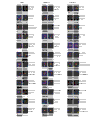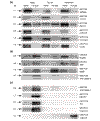Evaluation of differential gene expression during behavioral development in the honeybee using microarrays and northern blots
- PMID: 11864369
- PMCID: PMC65684
- DOI: 10.1186/gb-2002-3-2-research0007
Evaluation of differential gene expression during behavioral development in the honeybee using microarrays and northern blots
Abstract
Background: The honeybee (Apis mellifera) has been used with great success in a variety of behavioral studies. The lack of genomic tools in this species has, however, hampered efforts to provide genome-based explanations for behavioral data. We have combined the power of DNA arrays and the availability of distinct behavioral stages in honeybees to explore the dynamics of gene expression during adult development in this insect. In addition, we used caffeine treatment, a procedure that accelerates learning abilities in honeybees, to examine changes in gene expression underlying drug-induced behavioral modifications.
Results: Spotted microarrays containing several thousand cDNAs were interrogated with RNAs extracted from newly emerged worker bees, experienced foragers and caffeine-treated bees. Thirty-six differentially expressed cDNAs were verified by northern blot hybridization and characterized in silico by sequencing and database searches. Experienced foragers overexpressed royal jelly proteins, a putative imaginal disc growth factor, a transcriptional regulator (Stck) and several enzymes, including alpha-glucosidases, aminopeptidases and glucose dehydrogenase. Naive workers showed increased expression of members of the SPARC and lectin families, heat-shock cognate proteins and several proteins related to RNA translation and mitochondrial function. A number of novel genes overexpressed in both naive and experienced bees, and genes induced by caffeine, have also been identified.
Conclusions: We have shown the usefulness of this transcriptome-based approach for gene discovery, in particular in the context of the efficacy of drug treatment, in a model organism in which routine genetic techniques cannot be applied easily.
Figures


Similar articles
-
Differential gene expression in the hypopharyngeal glands of worker honeybees (Apis mellifera L.) associated with an age-dependent role change.Zoolog Sci. 2009 Aug;26(8):557-63. doi: 10.2108/zsj.26.557. Zoolog Sci. 2009. PMID: 19719408
-
Annotated expressed sequence tags and cDNA microarrays for studies of brain and behavior in the honey bee.Genome Res. 2002 Apr;12(4):555-66. doi: 10.1101/gr.5302. Genome Res. 2002. PMID: 11932240 Free PMC article.
-
Molecular determinants of caste differentiation in the highly eusocial honeybee Apis mellifera.BMC Dev Biol. 2007 Jun 18;7:70. doi: 10.1186/1471-213X-7-70. BMC Dev Biol. 2007. PMID: 17577409 Free PMC article.
-
Origin and function of the major royal jelly proteins of the honeybee (Apis mellifera) as members of the yellow gene family.Biol Rev Camb Philos Soc. 2014 May;89(2):255-69. doi: 10.1111/brv.12052. Epub 2013 Jul 16. Biol Rev Camb Philos Soc. 2014. PMID: 23855350 Review.
-
Insights into the molecular basis of social behaviour from studies on the honeybee, Apis mellifera.Invert Neurosci. 2008 Mar;8(1):1-9. doi: 10.1007/s10158-008-0066-6. Epub 2008 Feb 15. Invert Neurosci. 2008. PMID: 18274798 Review.
Cited by
-
Microarray and real-time PCR analyses of gene expression in the honeybee brain following caffeine treatment.J Mol Neurosci. 2005;27(3):269-76. doi: 10.1385/JMN:27:3:269. J Mol Neurosci. 2005. PMID: 16280596
-
Eph receptor and ephrin signaling in developing and adult brain of the honeybee (Apis mellifera).Dev Neurobiol. 2007 Feb 1;67(2):233-51. doi: 10.1002/dneu.20341. Dev Neurobiol. 2007. PMID: 17443785 Free PMC article.
-
Genomic dissection of behavioral maturation in the honey bee.Proc Natl Acad Sci U S A. 2006 Oct 31;103(44):16068-75. doi: 10.1073/pnas.0606909103. Epub 2006 Oct 25. Proc Natl Acad Sci U S A. 2006. PMID: 17065327 Free PMC article.
-
Characterization of a metabotropic glutamate receptor in the honeybee (Apis mellifera): implications for memory formation.Invert Neurosci. 2007 Jun;7(2):99-108. doi: 10.1007/s10158-007-0045-3. Epub 2007 Mar 20. Invert Neurosci. 2007. PMID: 17372777
-
mKast is dispensable for normal development and sexual maturation of the male European honeybee.Sci Rep. 2018 Aug 21;8(1):11877. doi: 10.1038/s41598-018-30380-2. Sci Rep. 2018. PMID: 30131569 Free PMC article.
References
-
- Ferea TL, Brown PO. Observing the living genome. Curr Opin Genet Dev. 1999;9:715–722. - PubMed
-
- Srinivasan MV, Zhang SW, Altwein M, Tautz J. Honeybee navigation: nature and calibration of the 'odometer'. Science. 2000;287:851–853. - PubMed
-
- Robinson GE, Fahrbach SE, Winston ML. Insect societies and the molecular biology of social behavior. BioEssays. 1997;19:1099–1108. - PubMed
-
- Menzel R, Müller U. Learning and memory in honeybees: from behavior to neural substrates. Annu Rev Neurosci. 1996;19:379–404. - PubMed
Publication types
MeSH terms
Substances
LinkOut - more resources
Full Text Sources
Miscellaneous

